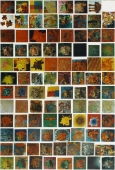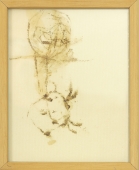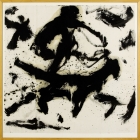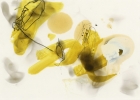
Artist | Yukio Fujimoto (*1950)
https://www.artist-info.com/artist/Yukio-Fujimoto
Biography
Biography
1950 born in Nagoya, Japan
Lives and works in Osaka
Solo Exhibitions (selection)
Solo Exhibitions (selection)
1986 Music of a Miniature Garden, North Fort Gallery, Osaka
1989 LiveYukio Sound Objects, Kodama Gallery, Osaka
1990 Ears of the Rooftop, Kodama Gallery, Osaka.
1992 FUJIMOTO Yukio Sound Objects: Fate & Chance, Hillside Gallery, Tokyo
1997 Audio Picnic at the Museum 4/10, Otani Memorial Art Museum, Nishinomiya City, Hyogo
2001 "Fast and Slow", Biennale die Venezia
Group Exhibitions (selection)
Group Exhibitions (selection)
1989 Moments Sonores, Tochigi Prefectural Museum of Fine Arts, Tochigi
1991 The World of Box, Contemporary Art Gallery, Art Tower Mito, Ibaragi
1992 UNDR/Kunst Videnskab Teknik, Charlotten borg, Copenhagen
1997 4th Kitakyushu Biennale: The Garden of the Senses Kitakyushu, Municipal Museum of Art, Kitakyushu
1999 Art of the Senses, Kunsthaus, Hamburg
2000 Art and Society: Earthquake, Taro Okamoto Museum of Art, Kawasaki
About the work
About the work
The Theme for the Japanese Pavilion "Fast & Slow" at the Biennale di Venezia 2001
At the first Venice Biennale of the 21" century, the Japan Pavilion has chosen the theme, "Fast &, Slow" to promote a perspective of slowing down, deceleration, in the cities, where everything seems to be moving faster.
The 20"' century was a century in which human beings were preoccupied with controlling the ehvironment, trying to make our lives faster, more efficient, and easier.The convenience of being able to supply the same 'things' regardless of one's location, however, led to further "stereotyping" by diminishing the existence of the cultural differences that are unique to each community. "Globalization", which is referred to within the purview of a standardized economy, has even made the facade of the cities throughout the world looking alike.We made unrelenting efforts in research and technical innovations in order to make our lives more convenient and comfortable, however, the other hand, the earth's resources, destruction of its environment, and global warming have become extremely serious issues.
Japan, as if it were a black hole, had absorbed various segments of European and American culture and economy, and built enormous cities. These cities may look like stereotypes, but they are in no way identical to the cities of Europe and the United States. In the city, which is dominated by a whirlwind of information and communication and a symbol of the age of abundance of 'things' and distribution, we are no longer able to submit ourselves to a single course of life, and neither is it easy to become aware of that fact. It is not easy to slow down and change the values by which we are presently governed.
In the exhibition of "Fast & Slow", we offer the multiple point of view of three artists through the scene of the city.
The Exhibit plan of the Japan Pavilion, "Fast & Slow"
We have decided to be mindful of symbiotic relationships and to present a 3?person exhibition, where they are both independent and dependent on one another. The 3 artists, who all work with different media, are Yukio Fujimoto, the sound artist, Naoya Hatakeyama, the photographer, and the artist, Masato Nakamura. As the Japan Pavilion has a piloti structure, a small room will be created on the lower piloti, and the works will be shown in the upper and lower halls. The displays will not be separated into the upper and lower halls, but the opening in the floor of the upper hall will be used to convey and link the ambiance of both galleries.
Fast(Upper Gallery)
As an introduction, 2 photographs of Osaka Stadium and a combination of photographs amounting to 70 fixed point observations of various sites in Tokyo by Naoya Hatakeyama will give an overlook of an entire city. Hatakeyarria reveals the dynamic transformation of a city in line with the time axis. Masato Nakamura's work enlarges the trademark of the hamburger shop, McDonald's, which are the 4.4 meters tall M and are new compositions created to tailor to this gallery, fills the entire gallery with yellow light. Nakamura is interested in the logo, which is a mutual language for every young person in the world even if he or she does not speak the language, and in the same quality of service offered at McDonald's, which has been compiled into a standardized manual. The visitor will wander about in the yellow light and in the sound of the chords from a keyboard. The sound also represents the unique realm of time?space of a city. The sound by Yukio Fujimoto will be implemented to enclose the whole gallery. The visual and auditory effects of the exhibition will create a space where speed, energy, uniformity, and electronic sounds of a city are all embodied.
2. Slow(Lower Gallery)
In the small gallery painted charcoal gray, 2 photographs from Hatakeyama's "Underground", in which he photographed the underground sewerage system in Shibuya, will be shown. Though the sewerage where filthy wastewater is drained is obviously unsanitary and a place detested by everyone, an almost noble spirit pervades in Hatakeyama's photographs. From Fujimoto's "Sugar", to be displayed in a small comer of the gallery, a delicate sound will generate from a sugar cube in a glass cylinder that revolves slowly. It is as if someone is actually there. However, the visitor must stop and listen very carefully or otherwise is likely to pass by without noticing. A faint yellow light will glow from the opening at the center of the ceiling. Time will flow slowly in this space and will transform any preconceived conceptions.
 offers / Requests offers / Requests  |
About this service |
|---|
 Exhibition Announcements Exhibition Announcements  |
About this service |
|---|
 Visualization |
Learn more about this service | ||
|---|---|---|---|

Interested in discovering more of this artist's networks?
3 easy steps: Register, buy a package for a visualization, select the artist.
See examples how visualization looks like for an artist, a curator, or an exhibition place: Gallery, museum, non-profit place, or collector.

Exhibition History

|
SUMMARY based on artist-info records. More details and Visualizing Art Networks on demand. Venue types: Gallery / Museum / Non-Profit / Collector |
||||||||||||
| Exhibitions in artist-info | 6 (S 1/ G 5) |
Did show together with - Top 5 of 88 artists (no. of shows) - all shows - Top 100
|
||||||||||
| Exhibitions by type | 6: 2 / 1 / 3 / 0 | |||||||||||
| Venues by type | 6: 2 / 1 / 3 / 0 | |||||||||||
| Curators | 1 | |||||||||||
| artist-info records | Sep 1993 - Feb 2018 | |||||||||||
|
Countries - Top 4 of 4 Japan (2) United Kingdom (1) Germany (1) Italy (1) |
Cities - Top 5 of 5 Osaka (2) Düsseldorf (1) London (1) Roma (1) Venezia (1) |
Venues (no. of shows )
Top 5 of 6
|
||||||||||
Curators (no. of shows)
Top 1 of 1
|
| Gallery Nomart | G | Jan 2018 - Feb 2018 | Osaka | (12) | +0 | |
| Dojima River Biennale 2013 | G | Jul 2013 - Aug 2013 | Osaka | (1) | +0 | |
| Tseng, Rudy (Curator) | +0 | |||||
| MAGAZZINO | G | Jul 2007 - Sep 2007 | Roma | (55) | +0 | |
| Hayward Gallery | G | Oct 2001 - Dec 2001 | London | (60) | +0 | |
| Biennale di Venezia - Japan | S | Jun 2001 - Nov 2001 | Venezia | (14) | +0 | |
| Stadtmuseum Düsseldorf | G | Sep 1993 - Sep 1993 | Düsseldorf | (16) | +0 | |
| Keep reading |







































